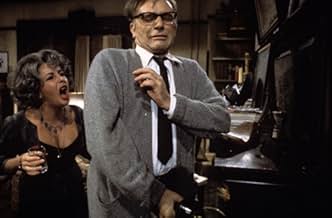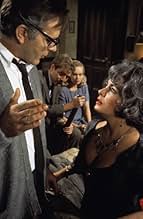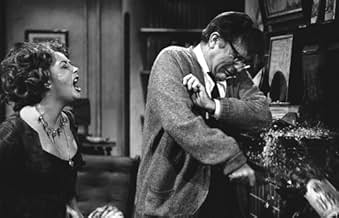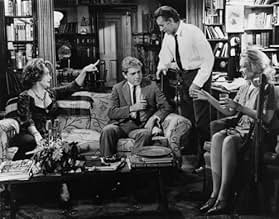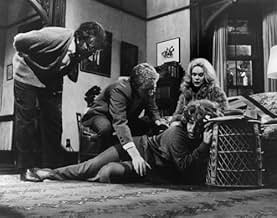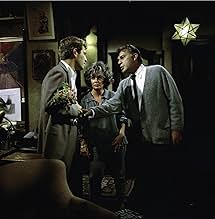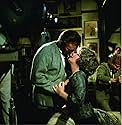Una pareja amarga y envejecida, con la ayuda del alcohol, usa a una pareja joven para alimentar la angustia y el dolor emocional entre ellos.Una pareja amarga y envejecida, con la ayuda del alcohol, usa a una pareja joven para alimentar la angustia y el dolor emocional entre ellos.Una pareja amarga y envejecida, con la ayuda del alcohol, usa a una pareja joven para alimentar la angustia y el dolor emocional entre ellos.
- Ganó 5 premios Óscar
- 22 premios ganados y 26 nominaciones en total
- Dirección
- Guionistas
- Todo el elenco y el equipo
- Producción, taquilla y más en IMDbPro
Opinión destacada
"Who's Afraid of Virginia Woolf?" walks a tightrope between comedy and tragedy. But regardless of the laughter this dark comedy elicits, we can all agree on one unanimous opinion: it's utterly terrifying.
"Terrifying" is a term too light, a shade too gray to stand out amid the dazzling kaleidoscope of emotions within this film.
The story in "Who's Afraid of Virginia Woolf?" unfolds over one night, as one crisis compounds onto another. George and Martha are a middle-aged couple, clearly losing their affection for each other. After a university party, they reluctantly invite another couple, Nick and Honey, to their home. Under the influence of alcohol and the fatigue of the late hour, every conflict, disagreement, and hidden facet of George-Martha and Nick-Honey's marriages gradually unravel in the most damaging ways.
Virginia Woolf was a prolific writer whose style delves deep into the thoughts of each character, exposing the reality of who they are. "Who's afraid of Virginia Woolf?" can be understood as "Who's afraid of living without illusion?" Do you remember Martha's response to George's question at the end of the film? George places his hand on Martha's shoulder and softly sings, "Who's afraid of Virginia Woolf?" Martha replies, "I am, George, I am." It signifies the confrontation between reality and illusion. But who doesn't have moments of fearing reality and escaping into illusions? Yet, the illusion in their minds often remains separate from reality. Unlike Martha and George, who embed illusions into their daily lives too frequently, to the point where Martha believes them to be real. So when she hears news of her son's death, she cries not because her illusion has shattered, but out of pity for that blend of illusion and reality. Her son might have been an illusion, but her suffering was real.
The film's characters feel remarkably authentic as well. They lack the flamboyant personas we often encounter in cinema; they could be anyone, neither entirely virtuous nor inherently wicked, neither deserving of our sympathy nor our ire. They are simultaneously relatable and infuriating, each simply navigating their own slice of life. This authenticity injects a profound sense of realism into the narrative, stripping away any semblance of fiction. While their story may not venture into uncharted territory, the interactions and conflicts between these characters elevate it to new heights, especially the portrayal of Liz Taylor's Martha. Her fiery temperament, piercing voice, seething anger, resentful glances at George, the ceaseless flow of alcohol, the chain of cigarettes, and the tears-all of these elements contribute to the film's atmosphere of stagnation.
The film's gripping intensity can be traced back to its theatrical origins. In the world of theater, we anticipate climaxes, revelations, and resolutions. With each passing moment, tension mounts, growing increasingly oppressive until it reaches a point where we must acknowledge that it cannot be neatly resolved. "Who's Afraid of Virginia Woolf?" transcends the boundaries of mere cinema; it's an unsettling voyage into the delicate equilibrium between illusion and reality. Within its intricate layers, terror and humor seamlessly intertwine, crafting a cinematic experience that leaves an enduring imprint.
"Terrifying" is a term too light, a shade too gray to stand out amid the dazzling kaleidoscope of emotions within this film.
The story in "Who's Afraid of Virginia Woolf?" unfolds over one night, as one crisis compounds onto another. George and Martha are a middle-aged couple, clearly losing their affection for each other. After a university party, they reluctantly invite another couple, Nick and Honey, to their home. Under the influence of alcohol and the fatigue of the late hour, every conflict, disagreement, and hidden facet of George-Martha and Nick-Honey's marriages gradually unravel in the most damaging ways.
Virginia Woolf was a prolific writer whose style delves deep into the thoughts of each character, exposing the reality of who they are. "Who's afraid of Virginia Woolf?" can be understood as "Who's afraid of living without illusion?" Do you remember Martha's response to George's question at the end of the film? George places his hand on Martha's shoulder and softly sings, "Who's afraid of Virginia Woolf?" Martha replies, "I am, George, I am." It signifies the confrontation between reality and illusion. But who doesn't have moments of fearing reality and escaping into illusions? Yet, the illusion in their minds often remains separate from reality. Unlike Martha and George, who embed illusions into their daily lives too frequently, to the point where Martha believes them to be real. So when she hears news of her son's death, she cries not because her illusion has shattered, but out of pity for that blend of illusion and reality. Her son might have been an illusion, but her suffering was real.
The film's characters feel remarkably authentic as well. They lack the flamboyant personas we often encounter in cinema; they could be anyone, neither entirely virtuous nor inherently wicked, neither deserving of our sympathy nor our ire. They are simultaneously relatable and infuriating, each simply navigating their own slice of life. This authenticity injects a profound sense of realism into the narrative, stripping away any semblance of fiction. While their story may not venture into uncharted territory, the interactions and conflicts between these characters elevate it to new heights, especially the portrayal of Liz Taylor's Martha. Her fiery temperament, piercing voice, seething anger, resentful glances at George, the ceaseless flow of alcohol, the chain of cigarettes, and the tears-all of these elements contribute to the film's atmosphere of stagnation.
The film's gripping intensity can be traced back to its theatrical origins. In the world of theater, we anticipate climaxes, revelations, and resolutions. With each passing moment, tension mounts, growing increasingly oppressive until it reaches a point where we must acknowledge that it cannot be neatly resolved. "Who's Afraid of Virginia Woolf?" transcends the boundaries of mere cinema; it's an unsettling voyage into the delicate equilibrium between illusion and reality. Within its intricate layers, terror and humor seamlessly intertwine, crafting a cinematic experience that leaves an enduring imprint.
- pulpficat
- 31 ago 2023
- Enlace permanente
Argumento
¿Sabías que…?
- TriviaThis became the first movie in Academy Awards history since Cimarron (1931) to be nominated for every Academy Award category in which it was eligible, including Best Adapted Screenplay (Ernest Lehman), Director (Mike Nichols), all of the acting categories (Richard Burton, Dame Elizabeth Taylor, George Segal and Sandy Dennis) and Picture of the Year (Ernest Lehman).
- ErroresThe four characters stop at a bar after the first soiree at George's house. It is clearly after 2:00 a.m., since the time was stated during the first segment. No bars, however, would have been open after 1 or 2 a.m. in the New England states, where the film is set.
- ConexionesEdited from La carta trágica (1940)
- Bandas sonorasWho's Afraid of Virginia Woolf?
(to the tune of "Here We Go Round the Mulberry Bush")
Traditional English melody
Original lyrics ("Who's Afraid of the Big Bad Wolf?") by Frank Churchill and Ann Ronell; modified by Edward Albee
Performed by Elizabeth Taylor
Selecciones populares
Inicia sesión para calificar y agrega a la lista de videos para obtener recomendaciones personalizadas
Detalles
- Fecha de lanzamiento
- País de origen
- Idiomas
- También se conoce como
- Who's Afraid of Virginia Woolf?
- Locaciones de filmación
- Cambridge, Massachusetts, Estados Unidos(location)
- Productoras
- Ver más créditos de la compañía en IMDbPro
Taquilla
- Presupuesto
- USD 7,500,000 (estimado)
- Total en EE. UU. y Canadá
- USD 28,000,000
- Total a nivel mundial
- USD 28,006,929
- Tiempo de ejecución2 horas 11 minutos
- Color
- Mezcla de sonido
- Relación de aspecto
- 1.85 : 1
Contribuir a esta página
Sugiere una edición o agrega el contenido que falta

Principales brechas de datos
By what name was ¿Quién le teme a Virginia Woolf? (1966) officially released in India in English?
Responda





